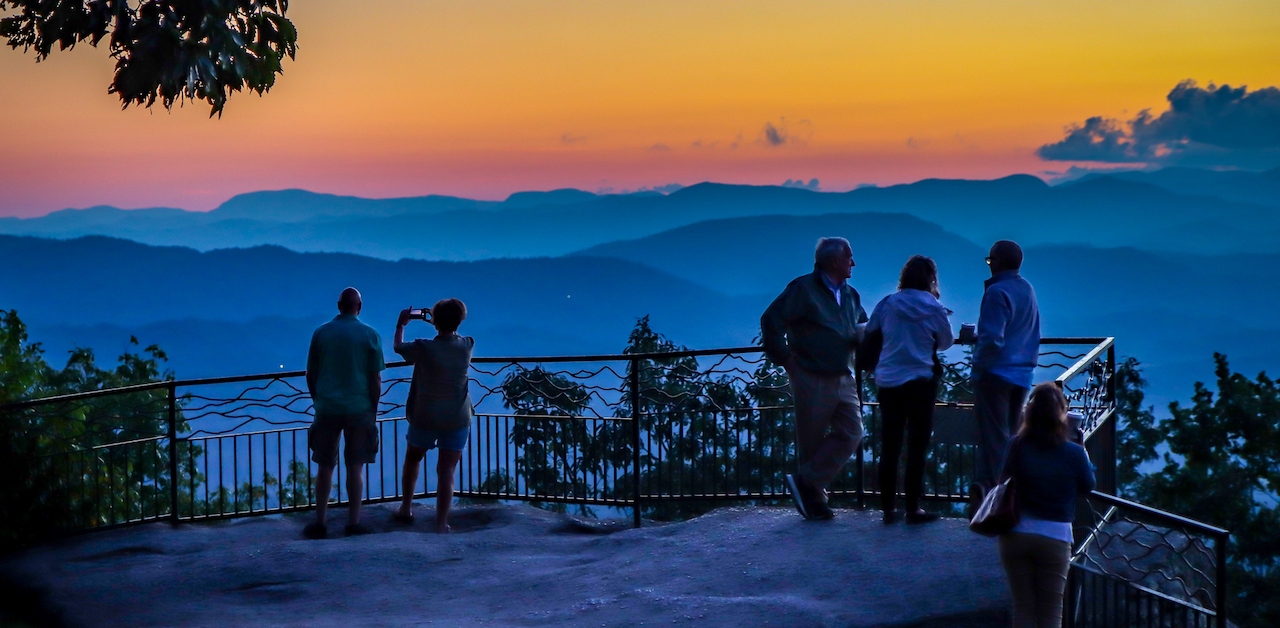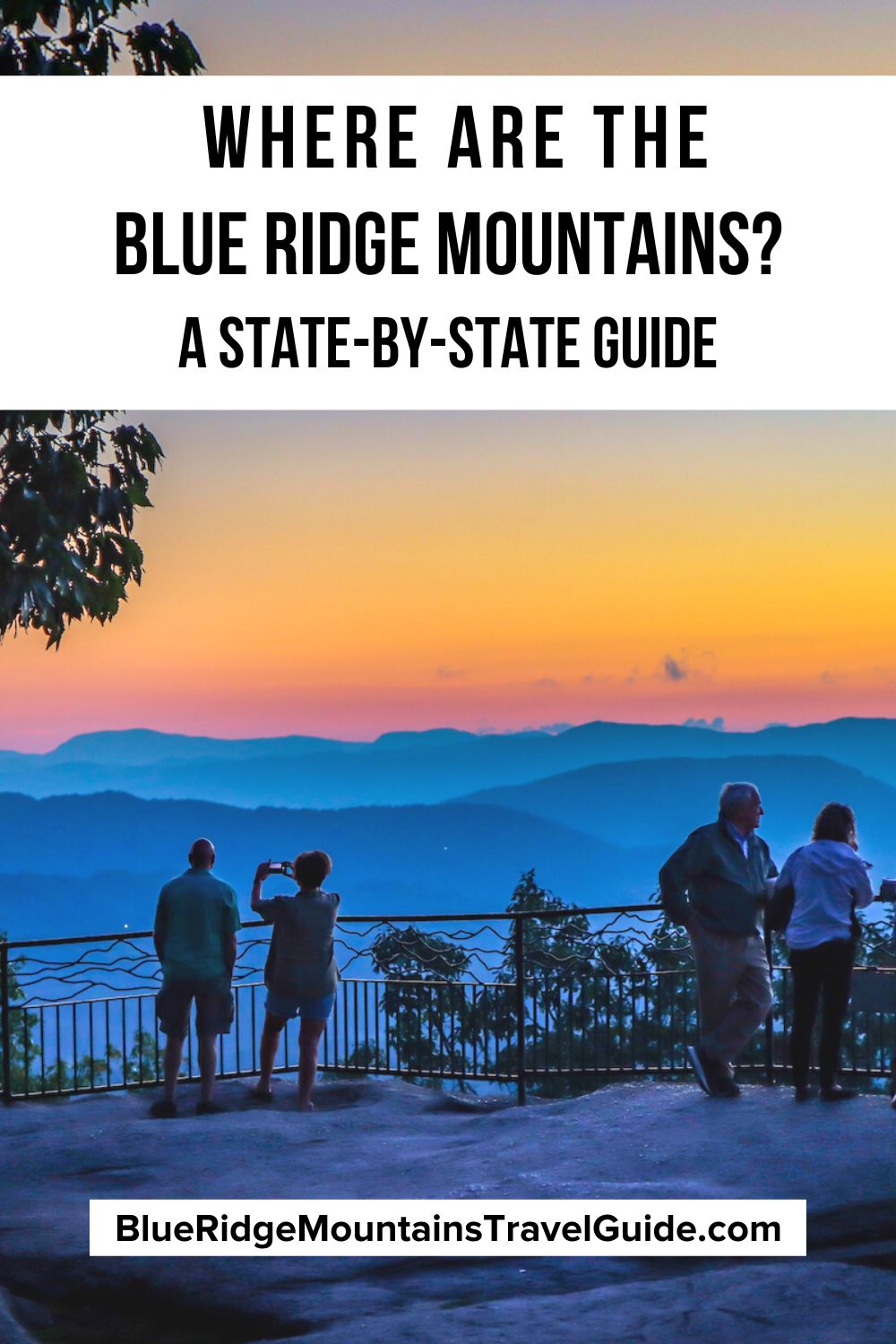“Where are the Blue Ridge Mountains?” is a question we get fairly often, and it’s understandable why so many people are confused by the geographical definition of the region.
Stretching 550 miles from North Georgia to Southern Pennsylvania, the Blue Ridge Mountain range is part of the larger Appalachian Mountain range. So all Blue Ridge Mountains are in the Appalachians, but not all Appalachian Mountains are part of the Blue Ridge.
The Blue Ridge Mountains are comprised of smaller sub-ranges, including the Great Smoky Mountains, the Great Balsams, the Roan Mountains, the Black Mountains, and the Brushy Mountains.
They span 8 states, including Pennsylvania, Maryland, West Virginia, and Virginia to the north, and North Carolina, South Carolina, Tennessee, and Georgia to the south.
This region features 2 national parks (Shenandoah & Great Smoky Mountains National Park) and 8 national forests, such as the Chattahoochee, Nantahala, Pisgah, and George Washington & Jefferson National Forests.
In short, Blue Ridge Mountains camping and hiking options are second to none. There are also a ton of quaint Blue Ridge Mountain towns that offer great hotels, resorts, and rental cabins.
The weather in the Blue Ridge Mountains is generally considered mild. Winter is generally tame enough to not be insufferable, while summer is cool enough to offer an escape from the lowlands.
But as residents of Elkin NC, our favorite seasons in the Blue Ridge Mountains are spring (when wildflowers and flowering trees bloom) and when the stunning fall colors begin to peak.
Read on for our state-by-state guide on where the Blue Ridge Mountains are, including geographic boundaries, noteworthy mountain towns to visit, and some of our favorite things to do there.
READ MORE: 20 Ways to Celebrate Christmas in the Blue Ridge Mountains
Where are the Blue Ridge Mountains? A State-by-State Guide
(Arranged Alphabetically by State)
- Blue Ridge Mountains in Georgia
- Blue Ridge Mountains in Maryland
- Blue Ridge Mountains in North Carolina
- Blue Ridge Mountains in Pennsylvania
- Blue Ridge Mountains in South Carolina
- Blue Ridge Mountains in Tennessee
- Blue Ridge Mountains in Virginia
- Blue Ridge Mountains in West Virginia
READ MORE:20 Incredible Places To See the Blue Ridge Mountains in Fall
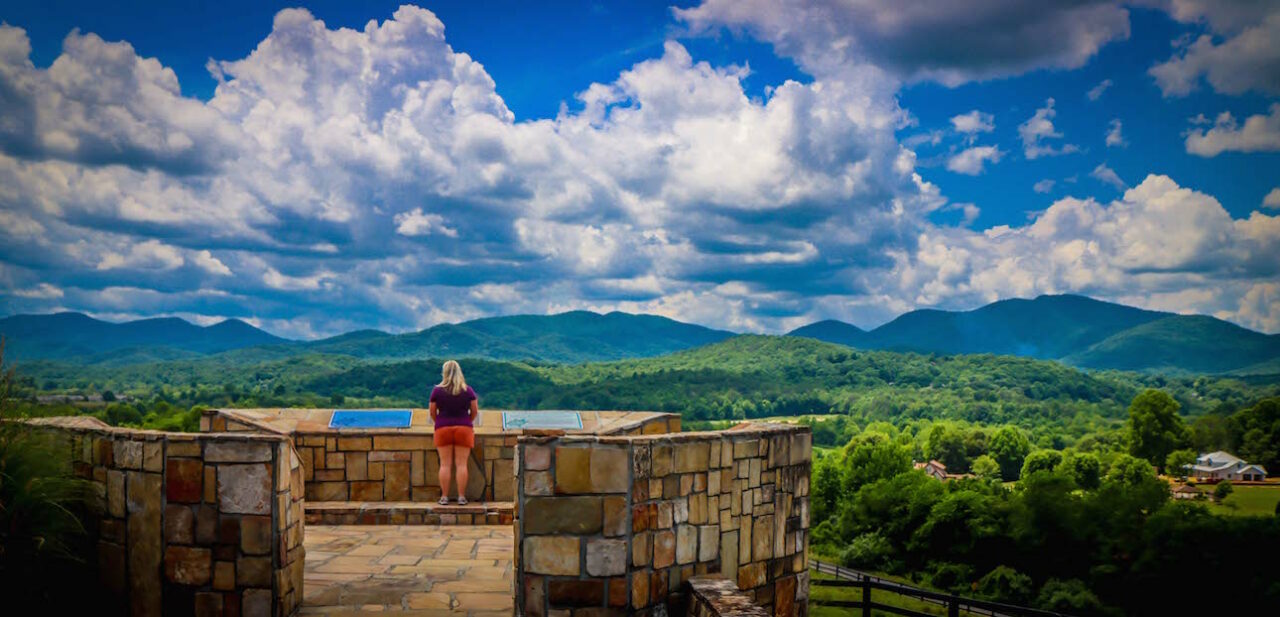
1. Blue Ridge Mountains in Georgia
The Blue Ridge Mountains of Georgia occupy the far northern region of the state, where Tennessee, North Carolina, and South Carolina all share boundaries.
Ten of the state’s highest peaks are located in this region, with Brasstown Bald (4,784 feet) being the tallest mountain in the State of Georgia.
Despite the Blue Ridge Mountains in GA encompassing a relatively small portion of the state, it’s arguably the biggest tourist draw outside of metro Atlanta.
Highlights of the Blue Ridge in Georgia include small towns like Blue Ridge, Dahlonega and Helen GA. They’re surrounded by the Chattahoochee National Forest, which offers over 100,000 acres of mountain wilderness.
There are over 300 miles of hiking trails in North Georgia for exploring the landscape, including the southern end of the Appalachian Trail at Springer Mountain.
Other noteworthy hiking trails (for a Georgia waterfall-lover like me) include quick treks to Minnehaha Falls, Helton Creek Falls, and Anna Ruby Falls, and longer treks to Amicalola Falls and Panther Creek Falls.
There are also 100 miles of trout streams for anglers, not to mention dozens of North Georgia lakes for boating, fishing, swimming, kayaking, and more. Lake Allatoona alone gets some 7 million visitors a year!
READ MORE: The 20 Best Places to Visit in Georgia
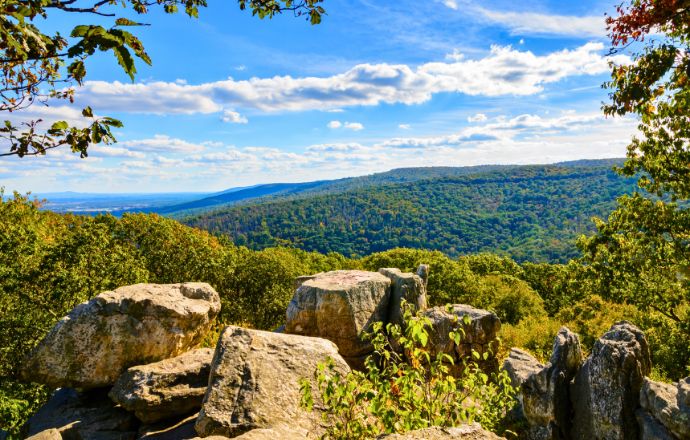
2. Blue Ridge Mountains in Maryland
The Blue Ridge Mountains dip into the northwest corner of Maryland, about 90 minutes north of Washington DC.
But the state isn’t really known as a marquee Blue Ridge destination like North Carolina or Virginia.
Maryland actually has three geological regions of the Appalachian Mountains Range: the Blue Ridge Mountains, the Appalachian Plateau, and the Ridge and Valley Provinces.
Most of the important Maryland mountains and hills are named for colonial explorers and settlers, and they’re most famous as important battle sites of the Civil War.
Both Sugarloaf Mountain and South Mountain saw major clashes between the Confederate and Union armies.
Catoctin Mountain in Maryland is also home to the world-renowned Presidential retreat, Camp David. The location was originally chosen by FDR, and later renamed by Eisenhower in honor of his grandson.
READ MORE: 40 Facts About the History of the Banjo (From Africa to Appalachia)
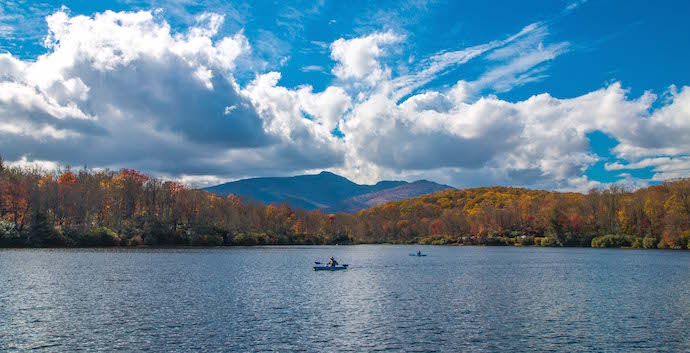
3. Blue Ridge Mountains in North Carolina
One of the most popular states for hiking in the Blue Ridge Mountains, North Carolina has well over a million acres of protected wilderness in the Blue Ridge region.
There are some fantastic mountain ranges in the Blue Ridge Mountains of North Carolina, including the Smokies, the Blacks, the Craggies, the Great Balsams, and more.
The Western side of the state is quite literally the Blue Ridge Mountains at their peak. Mount Mitchell (part of the Black Mountains) is the highest peak in North Carolina, in the Blue Ridge range, and east of the Mississippi River.
All 10 of the highest peaks in NC are divvied up between the Black Mountains, the Great Smoky Mountains, and the Great Balsam Mountains (the three highest North Carolina mountain ranges).
The Great Balsams feature the highest spot on the Blue Ridge Parkway (the 6,053-foot Richland Balsam Overlook), and Clingmans Dome is usually considered the highest in the Smokies at 6,643 feet.
North Carolina’s Blue Ridge has two national forests (Nantahala and Pisgah), two national parks (Great Smoky Mountains and the Blue Ridge Parkway), and half a dozen state parks in the region.
It’s also home to some of the finest campgrounds in North Carolina, 100 miles of the Appalachian Trail, 6 ski resorts for winter recreation, and lots of swimming holes to escape the heat in summer.
It also has Asheville, Boone, Blowing Rock, Brevard, and dozens of other amazing Blue Ridge mountain towns.
READ MORE: The 20 Best Places to Visit in North Carolina
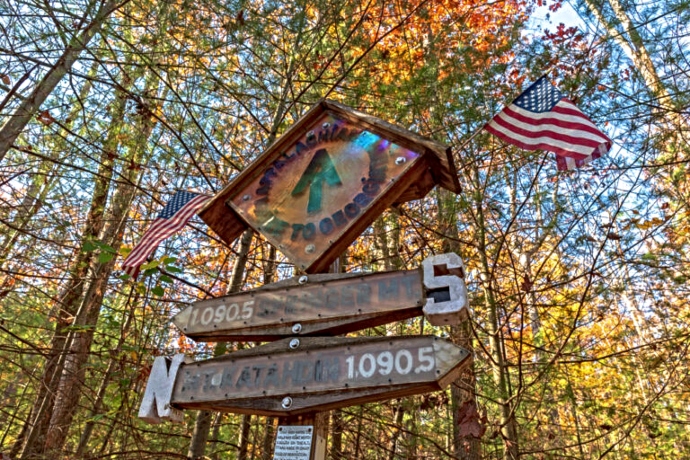
4. Blue Ridge Mountains in Pennsylvania
At their highest latitudinal location, the Blue Ridge Mountains just barely poke into Southern Pennsylvania.
The Blue Ridge Mountains of PA are wedged in between a sliver of Valley & Ridge and a sliver of Piedmont.
Most of the Appalachian range in Pennsylvania is part of the Appalachian Plateau, including the tallest mountain in Pennsylvania.
The highest mountain in PA is Mount Davis, which stands at an elevation of 3,213 feet, with the Blue Ridge visible to the east from it.
In terms of great hiking, the Blue Ridge Mountains in Pennsylvania have Blue Knob State Park (the second highest peak in PA), Pine Grove Furnace State Park, and Michaux State Forest.
South Mountain is another one of the most popular places in Pennsylvania’s Blue Ridge to check out, offering Appalachian Trail hiking and numerous nearby attractions.
READ MORE: What is Bluegrass? The History & Evolution of Appalachian Music

5. Blue Ridge Mountains in South Carolina
The Blue Ridge Mountains of South Carolina are relegated to the far northwestern corner of the state.
In fact, most of SC’s connection to Appalachia comes via the state’s Piedmont region
That being said, the Blue Ridge Mountains of SC (in conjunction with North Carolina) are home to the tallest waterfall east of the Rockies.
Upper Whitewater Falls is located in Nantahala National Forest in North Carolina, while Lower Whitewater Falls is ipart of Sumter National Forest in South Carolina.
You’ll only find the geologic Blue Ridge in Oconee County of South Carolina. But the geographic Blue Ridge Mountains extend to picturesque peaks such as Sassafras Mountain, Pinnacle Mountain, and Table Rock.
READ MORE: The 10 Best Things to Do in Cashiers NC & Jackson County
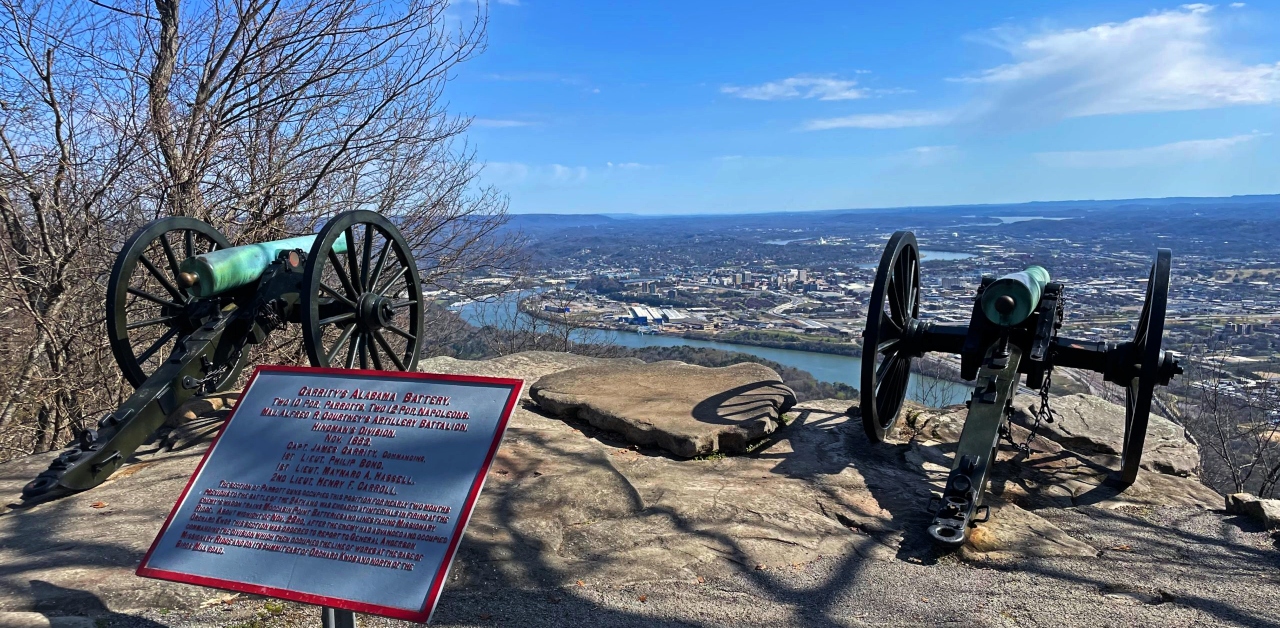
6. Blue Ridge Mountains in Tennessee
Along with Virginia and North Carolina, the Tennessee Blue Ridge Mountains contain many of the most iconic places to appreciate the grandeur that we love about the region.
And most of them are located in the sub-range known as the Great Smoky Mountains.
Only the far eastern mountain ranges in Tennessee are part of the Blue Ridge Mountains, primarily the Smokies and the Roan Mountains. But that’s plenty of space for their spectacular summits to make a memorable impression.
Great Smoky Mountains National Park is split between North Carolina and Tennessee, with its headquarters being in Gatlinburg TN.
North Carolina and Tennessee also share the tallest mountain in the park, Clingmans Dome.
Roan Mountain State Park is another beautiful Blue Ridge attraction that is well-suited to family camping. Popular activities there include visiting an old homestead and swimming/fishing/kayaking in the Doe River.
The Tennessee Valley Authority has also dotted the Blue Ridge landscape with recreational/power-producing/flood-preventing Tennessee lakes, all of which are well worth a visit!
READ MORE: The 15 Best Great Smoky Mountains Campgrounds to Visit

7. Blue Ridge Mountains in Virginia
Along with North Carolina, the Blue Ridge Mountains of Virginia take up the lion’s share of the range. That probably explains why the Blue Ridge Parkway is shared between these two states.
The Blue Ridge Mountains in VA include most of Southwest Virginia, stretching north across the Shenandoah Valley, into Shenandoah National Park, and on into Maryland.
Blue Ridge Mountain ranges in Virginia include the Bull Run Mountains, Catoctin Mountain, and Southwest Mountains. The highest mountains in the state of Virginia are in the Ridge-and-Valley Appalachians.
But the tallest peak in VA is actually Mount Rogers, which is in the Blue Ridge region and is part of George Washington & Jefferson National Forests.
There are also award-winning Virginia state parks sprinkled through the VA Blue Ridge, including Hungry Mother, Grayson Highlands, Natural Bridge, Natural Tunnel, and many more.
Shenandoah National Park is famed for its beautiful scenic route, Skyline Drive, as well as the Shenandoah River and Shenandoah Valley. The entire area is stunning, with loads of waterfalls, fabulous hiking trails, and insane views.
Virginia also has the longest section of the Appalachian Trail of any state, and nearly all of it takes hikers through the Blue Ridge Mountains.
Top Virginia mountain towns to visit in the Blue Ridge include Bristol, Lexington, Charlottesville, and Roanoke.
READ MORE: The 10 Best Virginia Wineries to Visit for Wine Tastings & Tours

8. Blue Ridge Mountains in West Virginia
Much like South Carolina, the Blue Ridge Mountains of West Virginia are barely a wisp.
They nip and tuck into the eastern reaches of the state– a region so small it’s barely visible on a map.
Nevertheless, there is the mountain town of Bluefield WV, which across the border from Bluefield VA.
They’re known as “nature’s air-conditioned city” for their cool temperatures, which are due to being at high elevation.
In addition to world-class whitewater rafting, the most well-known aspect of the Blue Ridge Mountains in West Virginia is Harpers Ferry and Harpers Ferry National Historic Park.
The town of Harpers Ferry is best known for its Civil War history. Visitors today can explore 19th-century buildings, a Civil War Museum, and John Brown’s Fort (which was the site of the famous 1859 abolitionist raid).
It’s located on the Shenandoah River, and runs through John Denver’s classic song about the Blue Ridge Mountains, “Country Roads”. –by Jonathon Engels; all photos by Bret Love & Mary Gabbett unless otherwise noted

